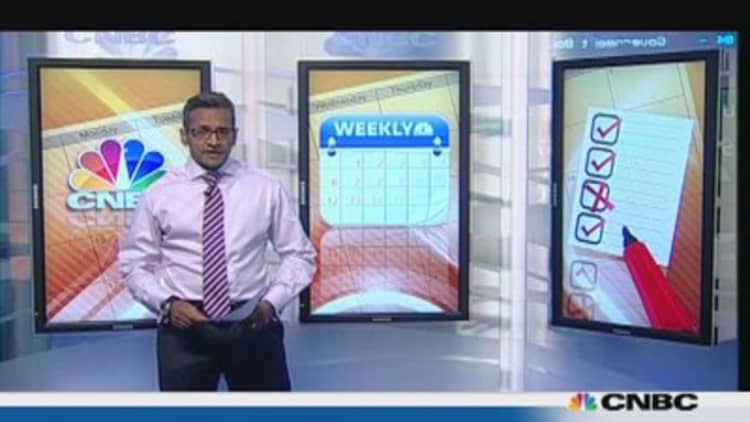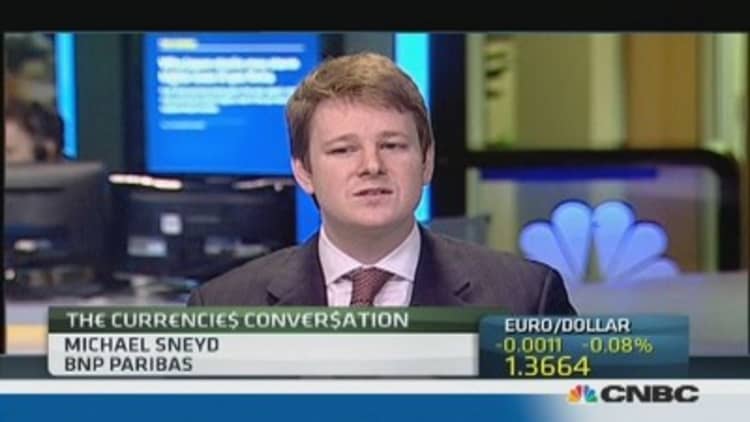
The economic cost of the U.S. government shutdown will keep the U.S. dollar under pressure this week, while the hit on business and consumer confidence could force the Federal Reserve to delay the withdrawal of stimulus until next year, according to CNBC's latest market survey of currency traders, analysts and strategists.
Many forecast the U.S. dollar index, which measures the greenback's value against a basket of currencies, to fall to fresh multi-month lows, possibly breaching 79.00. The index was at 79.63 on Monday.
"The dollar has traded very poorly on the back of the debt ceiling resolution against the Japanese yen, the euro and the Australian dollar," said Jens Nordvig, Global Head of G10 FX Strategy at Nomura.
(Read more: Taper talk sets tone for down and out dollar)
"It is hard to know if it is about a delay in growth and tapering or whether investors are starting to demand a political risk premium on the dollar. In any case, we are not inclined to trade the dollar from the bullish side at this point. In fact we are short dollar versus EM [emerging market] currencies," he said.
Nearly 89 percent (24 out of 27 respondents) believe the U.S. dollar will slide this week, according to CNBC's latest poll of currency market sentiment. Just 7 percent (2 out of 27) say the dollar will gain, while one respondent is 'neutral' and expects the dollar to trade around current levels.
U.S. dollar index 6-month chart:
Ray Attrill, co-head of currency strategy, said though the current period of dollar depreciation isn't over, the findings of CNBC's latest poll show "extreme" negative sentiment against the greenback and may signal that the currency is close to a turning point.
Still, dollar rallies may be short-lived, said Lasanka Perera, managing director at Global FX Partners in Sydney.
(Read more: 'Unnecessary damage' to economy from shutdown)
"There will be some short-covering at first - DXY [the dollar index] may head back up towards 80.00 over the next couple of days," Perera said, but sub-par U.S. jobs data this Tuesday could undermine any dollar advances, while the euro, Australian dollar and the British pound "will rally on positive data points in those regions and higher risk appetite."
Nomura's Nordvig said the investment bank has entered two new trades: Betting on a gain in the British pound against the Swiss franc and going 'short' Japanese yen, or betting the currency will fall, against the and the greenback.
"We have gone long sterling/Swiss franc around 1.4650," Nordvig said. "This trade is set to benefit from continued recovery in the U.K. economy (which should see euro/Swiss franc higher). We have been trading sterling from the long side for some time - this is an addition to the theme."
Expanding on Nomura's bearish bet on the yen, Nordvig explained: "We believe that Japanese capital outflows could pick up due to the resolution in the U.S., seasonality and the much changed real rate differential and related asset re-allocation among Japanese institutions."
Payrolls Tuesday
For the embattled U.S. dollar, delayed September U.S. jobs numbers scheduled for release this Tuesday represent the main risk event.
Economists polled by Thomson Reuters expect a payrolls gain of 180,000 for September and for the unemployment rate to remain unchanged at 7.3 percent.
"It will take a strong payrolls [reading] to put the dollar square," said Greg Gibbs, senior currency strategist at RBS. "It's hard to over-complicate this one...all risks to the downside."
This week's closely-watched jobs report will pre-date the shutdown's impact on the job market. The October reading - due out on November 8 - will likely reveal the full extent of hiring intentions and the hit on job-seeker confidence caused by the budget impasse.
Currency markets will likely "look beyond (Tuesday's) data as the Fed will need to measure the amplitude of the hit to growth and consumer sentiment," said Sebastien Galy, foreign exchange strategist at Societe Generale in New York. "Weakness in the U.S. dollar is a reflection indeed of the expected economic impact."
Strategically, Galy said the dollar still has some room to weaken against emerging market currencies: "There is still some significant illiquidity premium to be captured there and very large long U.S. dollar versus EM positions."
(Read more: Debt deal done, but dollar's demise deep-rooted)
However, the dollar has already "undershot" against some G10 currencies, Galy added. The euro "should be the first one to lose upward momentum against the dollar as the search for yield in Europe is at a very advanced stage," he said.
Taper delayed
Dollar bears are also banking on the Fed delaying the withdrawal of stimulus until at least the beginning of 2014.
Nizam Idris, head of fixed income and currency strategy at Macquarie Bank, told CNBC's 'Squawk Box' that the Fed "will play it safe" and start scaling back bond purchases in March at the earliest.
"The bullish dollar story has been shunted into 2014," said Simon Grose-Hodge, head of investment advisory at LGT Bank in Singapore. "The dollar certainly looks vulnerable on the Fed outlook."

Kathy Lien, managing director at BK Asset Management added: "The main takeaway from the budget battle is that the Fed will need to maintain its current level of asset purchases for the rest of the year."
Concern about softness in future months' data "will limit the dollar's appreciation in the week ahead and potentially drive it lower," Lien said.
Some forecasters are still keeping the door open to a Fed taper this year and dollar declines this week may not be a foregone conclusion if the September jobs report beats forecasts.
(Read more: Cramer: Dollar is a laughing stock worldwide)
"Stronger-than-expected labor market numbers are likely to provide some support to U.S. yields and the U.S. dollar, disrupting the recent trend," said Hamish Pepper, currency strategist at Barclays, who is bullish the dollar this week. "The Fed's taper decision will ultimately be tied to U.S. economic data and December remains the most likely timing, given our forecast for job creation will be stronger in Q4 than in Q3."
Barclays forecasts a September payrolls gain of 192,000 which may drive unemployment down to 7.2 percent. "We expect only those currencies with sufficiently strong fundamentals to post further gains against the U.S. dollar in the coming months."
Data vacuum
David Kotok, chief investment officer at U.S. money manager Cumberland Advisors, with $2.3 billion in assets under management, said the U.S. dollar will strengthen "but only after Washington has clarity and tapering begins."
Policy-making at the Fed will no doubt be complicated by the data vacuum caused by the over two-week shutdown earlier this month and the revised schedule of data.
"November's releases are likely to have quite a large standard deviation," said Joel Murphy, a currency analyst and market commentator for Forex Broker Pepperstone. "My hope would be that Ben Bernanke invites Janet Yellen to the FOMC press conference on October 30 to explain what their view of likely comprised data will be and how they will include it in their deliberation going forward as Yellen takes over."
From a technical perspective, Matt Fanning, Founder and CIO of Fanvestments, highlighted 79.70 as a key level that the U.S. dollar index needs to hold. Should 79.70 be violated, 79.00 is next key support and if that fails, DXY risks a test of 76.00.
"I'm still bearish due to taper being postponed and a continued dovish Fed being handed new dovish reins with Janet Yellen. I do think taper happens next year... I would say Q2 as of now."
— By CNBC's Sri Jegarajah. Follow him on Twitter @cnbcSri



